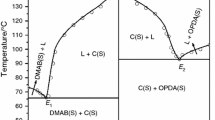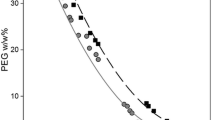Abstract
Phase diagrams for H2O-DMF-PCL ternary system and with the presence of inorganic additives, H2O-DMF-PCL–(TiO2/MMT) quaternary system are studied using Flory–Huggins theory, which explains the thermodynamic behavior of polymeric membranes formed out of phase inversion process. The experimental binodal curves were plotted using cloud points obtained from the titration method. Also, the experimental spinodal curve was drawn using the compositions at the onset of phase separation in the titration method and found matching with the theoretical spinodal curve. The effect of variations in the interaction parameters on the location of the binodal curve is studied. The ternary interaction parameter was determined by fitting the binodal curve with the cloud point data for the ternary and quaternary system. The interaction of PCL-DMF-H2O is found to be consistent even in the presence of TiO2 or MMT. Also, the ternary and quaternary interaction parameters involving these additives were found to be negligible within the system. On the other hand, the presence of additives shifted the binodal curve toward the solvent-polymer axis manifesting the less requirement of non-solvent for phase separation. The critical point for the ternary system obtained in both experiment and theoretical calculation was at the polymer concentration of around 6 wt%. Membranes having composition above the critical point were synthesized using phase inversion technique, and their morphology was examined using SEM images.











Similar content being viewed by others
References
Zhang S, Liu Y, Li D, Wang Q, Ran F (2019) Water-soluble MOF nanoparticles modified polyethersulfone membrane for improving flux and molecular retention. Appl Surf Sci. https://doi.org/10.1016/j.apsusc.2019.144553
Mazinani S, Darvishmanesh S, Ehsanzadeh A, Van der Bruggen B (2017) Phase separation analysis of EXTEM/solvent/non-solvent systems and relation with membrane morphology. J Memb Sci 526:301–314. https://doi.org/10.1016/j.memsci.2016.12.031
El-gendi A, Abdalla H, Ali S (2012) Construction of ternary phase diagram and membrane morphology evaluation for polyamide/formic acid/water system. Aust J Basic Appl Sci 6:62–68
Young TH, Chuang WY (2002) Thermodynamic analysis on the cononsolvency of poly (vinyl alcohol) in water-DMSO mixtures through the ternary interaction parameter. J Memb Sci 210:349–359. https://doi.org/10.1016/S0376-7388(02)00413-1
Liu L, Xiang H, Huang Z, Chen L, Yu J, Zhu J, Hu Z (2013) Calculation of the phase diagram of a btda-tdi/mdi co-polyimide/N-methyl-2-pyrrolidinone/water system in the phase separation process. Text Res J. https://doi.org/10.1177/0040517512456762
Kurada KV, De S (2017) Modeling of solution thermodynamics: a method for tuning the properties of blend polymeric membranes. J Memb Sci 540:485–495. https://doi.org/10.1016/j.memsci.2017.06.049
Sadrzadeh M, Bhattacharjee S (2013) Rational design of phase inversion membranes by tailoring thermodynamics and kinetics of casting solution using polymer additives. J Memb Sci 441:31–44. https://doi.org/10.1016/j.memsci.2013.04.009
Panda SR, De S (2015) Preparation, characterization and antifouling properties of polyacrylonitrile/polyurethane blend membranes for water purification. RSC Adv 5:23599–23612. https://doi.org/10.1039/c5ra00736d
Bakeri G, Ismail AF, Rahimnejad M, Matsuura T (2014) Analysis of polyetherimide/N-methyl-2-pyrrolidone/nonsolvent phase separation behavior. J Polym Res 21:386. https://doi.org/10.1007/s10965-014-0386-7
Ebrahimpour M, Safekordi AA, Nasab AH, Mousavi SM (2016) Phase separation analysis in the ternary system of poly (butylene succinate)/1,1,2,2-tetrachloroethane/non-solvent in relation to membrane formation. Inter Bus Manag 10:5876–5884
Idris A, Man Z, Maulud AS, Khan MS (2017) Effects of phase separation behavior on morphology and performance of polycarbonate membranes. Membranes (Basel). https://doi.org/10.3390/membranes7020021
Hak J, Ryul B, Won J, Chae H, Soo Y (2001) Phase behavior and mechanism of membrane formation for polyimide/DMSO/water system. J Memb Sci 187:47–55
Wei Y, Xu Z, Yang X, Liu H (2006) Mathematical calculation of binodal curves of a polymer/solvent/nonsolvent system in the phase inversion process. Desalination 192:91–104. https://doi.org/10.1016/j.desal.2005.07.035
Altena FW, Smolders CA (1982) Calculation of liquid-liquid phase separation in a ternary system of a polymer in a mixture of a solvent and a nonsolvent. Macromolecules 15:1491–1497. https://doi.org/10.1021/ma00234a008
Keshavarz L, Khansary MA, Shirazian S (2015) Phase diagram of ternary polymeric solutions containing nonsolvent/solvent/polymer: theoretical calculation and experimental validation. Polymer (Guildf) 73:1–8. https://doi.org/10.1016/j.polymer.2015.07.027
Tan L, Pan D, Pan N (2008) Thermodynamic study of a water–dimethylformamide–polyacrylonitrile ternary system. Appl Polym Sci 110:3439–3447. https://doi.org/10.1002/app.28392
Gierszewska M, Ostrowska-Czubenko J (2016) Equilibrium swelling study of crosslinked chitosan membranes in water, buffer and salt solutions. Prog Chem Appl Chitin Its Deriv 21:55–62. https://doi.org/10.15259/PCACD.21.05
Mohsenpour S, Safekordi A, Tavakolmoghadam M, Rekabdar F, Hemmati M (2016) Comparison of the membrane morphology based on the phase diagram using PVP as an organic additive and TiO2 as an inorganic additive. Polymer (Guildf) 97:559–568. https://doi.org/10.1016/j.polymer.2016.05.069
Wang R, Schuman T, Vuppalapati RR, Chandrashekhara K (2014) Fabrication of bio-based epoxy-clay nanocomposites. Green Chem 16:1871–1882. https://doi.org/10.1039/c3gc41802b
Bordes C, Fréville V, Ruffin E, Marote P, Gauvrit JY, Brianc S, Lantéri P (2010) Determination of poly (ε-caprolactone) solubility parameters: application to solvent substitution in a microencapsulation process. Int J Pharm 383:236–243. https://doi.org/10.1016/j.ijpharm.2009.09.023
Brandrup J, Immergut EH (1999) E.A.G. E, Polymer Handbook, 4th edition edn. Wiley, New York
Aryanti PTP, Ariono D, Hakim AN, Wenten IG (2018) Flory–Huggins based model to determine thermodynamic property of polymeric membrane solution. J Phys Conf Ser. https://doi.org/10.1088/1742-6596/1090/1/012074
Abdallah H, Amin A, El-Gendi A, El-Bayoumi M (2017) Quaternary polymeric thermodynamic system and membrane formation mathematical model. ARPN J Eng Appl Sci 12:2177–2191
Kimmerle K, Strathmann H (1990) Analysis of the structure-determining process of phase inversion membranes. Desalination 79:283–302. https://doi.org/10.1016/0011-9164(90)85012-Y
Boom RM, van den Boomgaard T, Smolders CA (1994) Mass transfer and thermodynamics during immersion precipitation for a two-polymer system. Evaluation with the system PES-PVP-NMP-water. J Memb Sci 90:231–249. https://doi.org/10.1016/0376-7388(94)80074-x
Bin Li H, Shi WY, Zhang YF, Liu DQ, Liu XF (2014) Effects of additives on the morphology and performance of PPTA/PVDF in situ blend UF membrane. Polymers (Basel) 6:1846–1861. https://doi.org/10.3390/polym6061846
Madaeni SS, Bakhtiari L (2012) Thermodynamic-based predictions of membrane morphology in water/dimethylsulfoxide/polyethersulfone systems. Polymer (Guildf) 53:4481–4488. https://doi.org/10.1016/j.polymer.2012.07.005
Barzin J, Sadatnia B (2007) Theoretical phase diagram calculation and membrane morphology evaluation for water/solvent/polyethersulfone systems. Polymer (Guildf) 48:1620–1631. https://doi.org/10.1016/j.polymer.2007.01.049
Munirasu S, Nunes SP (2014) Porous asymmetric SiO2-g-PMMA nanoparticles produced by phase inversion. J Mater Sci 49:7399–7407. https://doi.org/10.1007/s10853-014-8434-6
Machado PST, Habert AC, Borges CP (1999) Membrane formation mechanism based on precipitation kinetics and membrane morphology. J Memb Sci 155:171–183
Acknowledgements
Authors acknowledge National Institute of Technology Calicut for providing necessary funding for the successful completion of the project.
Author information
Authors and Affiliations
Corresponding author
Ethics declarations
Conflict of interest
The authors declare that they have no known competing financial interests or personal relationships that could have appeared to influence the work reported in this paper.
Additional information
Publisher's Note
Springer Nature remains neutral with regard to jurisdictional claims in published maps and institutional affiliations.
Rights and permissions
About this article
Cite this article
Nivedita, S., Ahamed, D. & Joseph, S. Thermodynamic analysis of phase diagram of H2O-DMF-PCL system: investigation on the influence of inorganic additives TiO2/MMT. J Mater Sci 55, 5431–5444 (2020). https://doi.org/10.1007/s10853-020-04386-z
Received:
Accepted:
Published:
Issue Date:
DOI: https://doi.org/10.1007/s10853-020-04386-z




